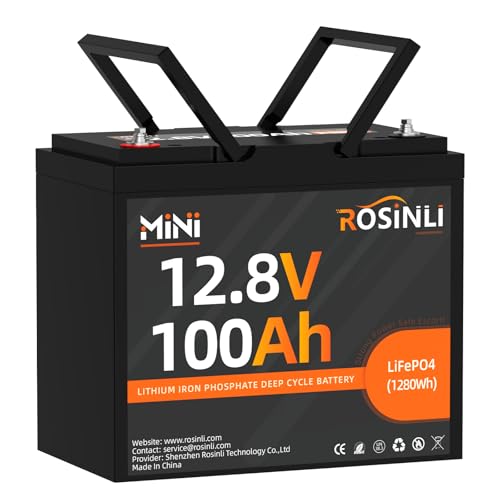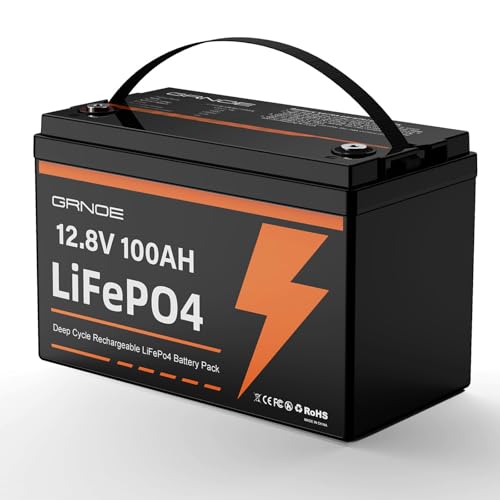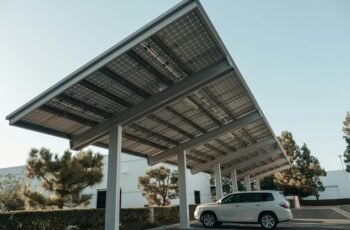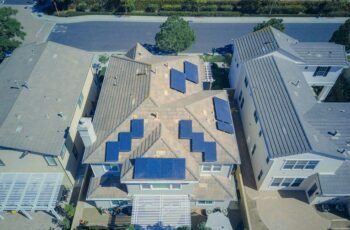Choosing the right 12V 100Ah LiFePO4 battery can make or break our off-grid, RV, or marine setup. We’ve compared the top five picks of 2025 for reliable BMS protection, real-world cycle life, and smart form factors that fit tight trays. We’ll touch on warranty strength, charging specs, and build quality that stands up to the elements. Let’s break down which models actually deliver—and which ones to skip—so you can power up with confidence.
Key Takeaways
- Prioritize batteries with robust BMS protections (over/under-voltage, over-current, short-circuit, temperature) and clear 14.6V LiFePO4 charging compatibility.
- Look for high cycle life claims (2,000–5,000+ cycles) and solid warranties (24–60 months) to ensure long-term value.
- Choose the right form factor: Mini for tight bays, Group 24/31 for standard drop-in replacements with ~1.28 kWh usable energy.
- Verify real-time monitoring features (SOC display/Bluetooth) and IP ratings (IP65–IP67) for reliability in RV, marine, and off-grid use.
- Ensure scalability to 24V/48V or higher Ah via safe series/parallel expansion, with balanced charging and proper solar/alternator integration.
12V 100Ah Mini LiFePO4 Battery with Built-in BMS for RV, Marine, Solar, and Home Storage
November 19, 2025 4:07 pm
Looking for a compact 12V 100Ah that still packs real capacity? We like this Mini LiFePO4 for RV, marine, solar, camping, and home storage. It’s smaller than Group 24, just 20.9 lb, and measures 5.4D x 9.2W x 8.35H. The automotive-grade cells deliver higher energy density and stable performance, and the built-in smart BMS safeguards against over-charge, over-discharge, over-current, and short-circuit.
We can scale it: up to 4S or 4P for 48V (51.2V) or 400Ah. Charge with a LiFePO4 charger (14.6V/20A), solar controller, or alternator. It’s for energy storage, not engine starting. Warranty: five years, plus tech support.
Best For: RVers, boaters, and off‑grid users who need a compact, lightweight 12V 100Ah LiFePO4 battery for energy storage with scalable capacity (up to 48V or 400Ah) and built-in protection.
Pros:
- Compact and lightweight (20.9 lb; smaller than Group 24) with automotive‑grade LiFePO4 cells for high energy density and stable performance
- Built‑in smart BMS for over‑charge, over‑discharge, over‑current, and short‑circuit protection; supports up to 4S/4P configurations
- Flexible charging options (14.6V/20A LiFePO4 charger, solar with controller, alternator) and 5‑year warranty with tech support
Cons:
- Not suitable for engine starting; designed strictly for energy storage applications
- Some users report mixed experiences with warranty/service responsiveness
- Requires correct LiFePO4 charging profile; may need connector/terminal adapters depending on setup
12V 100Ah LiFePO4 Battery with Display (Group 24)
November 19, 2025 1:49 am
Need a compact, Group 24 drop-in that still delivers real-time insight? We like this 12V 100Ah LiFePO4 with Display for its 1280Wh capacity, Grade‑A cells, and 20‑pound weight. The digital meter shows voltage and state of charge, so you know exactly what’s left. It replaces lead-acid at roughly 70% less weight and needs no maintenance.
The built-in 100A BMS safeguards against overcharge, overdischarge, overcurrent, and extreme temps. IP67 housing shrugs off dust, moisture, and light salt spray. It’s ideal for RVs, boats, solar, UPS, and hurricane backup; powers motors, fridges, lighting, and Starlink. Go 4P4S for expansion—set each to 10V before series linking. Includes M8 hardware. Reviews: 4.6/5.
Best For: RVers, boaters, and off‑grid users who want a compact Group 24 drop‑in LiFePO4 with a built‑in display, high cycle life, and low weight to replace lead‑acid.
Pros:
- Lightweight 20 lb Group 24 form factor replaces lead‑acid at ~70% less weight with 1280Wh capacity
- Built‑in display shows real‑time voltage and state of charge; Grade‑A cells and 100A BMS protection
- IP67 housing resists dust, moisture, and light salt spray; supports 4P4S expansion
Cons:
- Requires setting each battery to 10V before series linking, adding a setup step
- 100A BMS limit may constrain very high surge loads
- General warranty info only; relies on Amazon return policy for straightforward support
12V 100Ah LiFePO4 Lithium Battery with 100A BMS (Group 24)
November 19, 2025 8:45 pm
Serious off-grid campers and RV owners who want compact power without extra weight will appreciate this 12V 100Ah LiFePO4 (Group 24) with a 100A BMS. We get 1.28kWh in a 20.9 lb package that fits standard Group 24 trays, delivering up to 100A continuous discharge. The Grade A+ LiFePO4 cells and smart BMS guard against overcharge, over-discharge, over-current, short circuit, and temperature extremes, with charging cut off below 32°F and discharging below -4°F. Expect up to 15,000 deep cycles and a 10-year lifespan. It supports series/parallel builds to 20.48kWh (4S) and unlimited parallel. Warranty: 24 months, plus 24/7 support.
Best For: Off-grid campers, RV owners, and small solar setups needing compact, lightweight Group 24 power with high cycle life and 100A continuous output.
Pros:
- Lightweight 20.9 lb Group 24 form factor with 1.28kWh—about 2–3× the usable energy of similar-sized SLA
- Smart 100A BMS with comprehensive protections and high-grade A+ LiFePO4 cells for long life (up to 15,000 cycles)
- Flexible system growth: series up to 4 (48V) for 20.48kWh and unlimited parallel expansion
Cons:
- Charging restricted below 32°F and discharging below -4°F may limit cold-weather use without heating
- 100A max continuous discharge may be insufficient for very high-draw inverters or large trolling motors
- Higher upfront cost than lead-acid despite lower long-term cost per cycle
12V 100Ah Mini LiFePO4 Battery with Built-in BMS for RV, Marine, Solar, and Home Energy Storage
November 19, 2025 4:07 pm
Compact yet capable, this 12V 100Ah Mini LiFePO4 stands out for RVers, boaters, and off‑grid users who need high energy density in a smaller-than-Group-24 footprint with a built-in BMS. We like its 20.9 lb weight and compact 5.4D x 9.2W x 8.35H dimensions that slip into tight bays. Automotive-grade cells deliver stable power for solar, RV, marine, camping, trolling motors, UPS, and home storage—just not engine starting. The smart BMS guards against over-charge, over-discharge, over-current, and shorts. Scale up to 4S or 4P (max 48V/400Ah). Charge with a 14.6V LiFePO4 charger (20A), solar controller, or alternator/generator. Backed by a 5‑year warranty.
Best For: RVers, boaters, and off‑grid users needing a compact, lightweight 12V 100Ah LiFePO4 battery with built‑in BMS for energy storage (not engine starting), scalable up to 48V/400Ah.
Pros:
- Compact and lightweight (20.9 lbs; 5.4D x 9.2W x 8.35H) fits tight bays and smaller-than-Group-24 spaces
- Built-in smart BMS for over-charge, over-discharge, over-current, and short-circuit protection; automotive-grade cells
- Flexible system design: up to 4S or 4P configurations; multiple charging options (14.6V LiFePO4 charger, solar with controller, alternator/generator)
Cons:
- Not suitable for engine starting applications
- Requires a proper LiFePO4 charging profile (14.6V recommended) for optimal performance and longevity
- Mixed user reports on warranty/service experiences despite a stated 5-year warranty
12V 100Ah LiFePO4 Battery with Built-in 100A BMS (Group 31)
November 19, 2025 11:25 pm
Looking for a true drop-in Group 31 that’s light, tough, and ready for multi-battery builds? This 12V 100Ah LiFePO4 fits standard trays (12.9 x 6.7 x 8.6 in), weighs about 22.5 lb, and packs 1280Wh with a built-in 100A BMS. We like its IP65 waterproofing and steady performance for RVs, boats, trolling motors (36–55 lb), and home backup. It’s energy storage, not a starter.
For expansions, you can run up to 4P4S (48V, 20.48kWh). Activate with a 14.6V LiFePO4 charger; avoid 12V/repair modes. Balance series packs within 0.2V, charge to 14V+. Max burst: 300A/3s. Warranty: 36 months. Recharge every 2–3 months.
Best For: RV, marine, and off-grid users needing a lightweight, Group 31 drop-in LiFePO4 battery for energy storage, trolling motors (36–55 lb), and scalable multi-battery builds up to 48V.
Pros:
- Lightweight Group 31 form factor (~22.5 lb) with 1280Wh and built-in 100A BMS; IP65 waterproof.
- Scalable up to 4P4S (48V, 20.48kWh) with strong surge capability (300A for 3 seconds).
- Reliable energy storage performance and 36-month warranty; fits standard trays and easy swaps.
Cons:
- Not a starting battery; unsuitable for engine cranking, golf carts, or jacks.
- Requires a 14.6V LiFePO4 charger; 12V/repair/desulfation modes can trigger BMS shutdown or cause damage.
- Needs voltage balancing (≤0.2V) before series connections and periodic recharging every 2–3 months.
Factors to Consider When Choosing LiFePO4 Batteries 12V 100Ah
Before we pick a 12V 100Ah LiFePO4, let’s match capacity and energy density to our load needs and confirm the BMS protections we require. We’ll weigh cycle life and warranty against size, weight, and fitment constraints in our setup. Finally, we’ll check charging compatibility—voltage profile, current limits, and charger type—to ensure safe, efficient performance.
Capacity and Energy Density
Why does capacity matter so much? Because it dictates how long we can run our loads between charges. A 12V 100Ah LiFePO4 stores about 1.2 kWh, commonly cited as ~1.28 kWh due to internal cell configurations. That’s meaningful runtime for fridges, inverters, and trolling motors without constant recharging.
Energy density is where LiFePO4 shines. We get roughly 2–3 times the usable capacity of lead-acid in the same footprint, and at about 20–22 pounds, it’s roughly half the weight of equivalent lead-acid. That’s easier installs and more power per pound.
Need more? We can scale: wire packs in series for 24V or 48V, or parallel for higher Ah, safely. With 2,000–5,000+ cycles at moderate DoD, usable energy over time far outpaces legacy chemistries.
BMS Protection Features
How does a great 12V 100Ah battery stay great after thousands of cycles? It starts with a smart BMS. We look for protection against overcharge, overdischarge, overcurrent, and short circuits, because these events damage cells and can create safety risks. Robust temperature thresholds matter too; a good BMS pauses charge or discharge when it’s too hot or too cold.
Setup is easier when the pack specifies clear activation and charging requirements. Many 12V 100Ah models need about 14.6V to wake the BMS and balance cells. That detail guides charger selection and wiring.
A protective BMS also shields the pack from improper chargers or miswiring, though aggressive modes like desulfation can trigger shutdowns. Strong BMS performance signals quality—and brands often back it with multi‑year coverage.
Cycle Life and Warranty
Even as specs and price catch our eye, cycle life and warranty determine real value over years of use. With LiFePO4, we’re typically looking at 4,000 to 15,000 deep cycles, depending on cell quality and how far we discharge each time. Shallow depths of discharge and moderate temperatures stretch total cycles, while deep discharges and heat shorten them.
That longevity translates into fewer replacements versus lead-acid, lowering total cost of ownership. On the warranty side, premium packs commonly carry 5–10 years of coverage for defects and workmanship. We should read the fine print: warranties usually exclude misuse, improper charging, and physical damage. Following the manufacturer’s charging profile protects both cycle life and coverage, helping us secure reliable performance and support throughout the battery’s service life.
Size, Weight, Fitment
Long service life only pays off if the battery actually fits our space and setup. A 12V 100Ah LiFePO4 typically weighs 20–22 pounds, so it’s far lighter than lead-acid and easier to handle in RVs, boats, and off-grid boxes. We should confirm the case size: compact Mini footprints (about 5.4″ D x 9.2″ W x 8.35″ H) or standard Group 24/31 help drop into existing trays with minimal changes.
Fitment isn’t just dimensions. We need proper clearance for cables, ventilation pathways, and secure mounting. Check terminal types—M8 posts or faston connectors (F2/F1)—to match our existing lugs or adapters. Planning multi-battery banks matters too: 4S to reach 48V or 4P for 400Ah requires tray capacity, cable routing space, and balanced weight distribution.
Charging Compatibility Requirements
Why does charging compatibility make or break a 12V 100Ah LiFePO4 setup? Because LiFePO4 needs a precise profile. We should use a dedicated charger that delivers 14.6V ± 0.2V; a generic 12V or lead‑acid charger won’t fully charge and can stress the BMS. The charger and any DC sources must play nicely with BMS protections—over‑charge, over‑discharge, and temperature—so we don’t trigger shutdowns or fault codes.
Planning series or parallel banks? Let’s keep chemistries identical and maintain tight balance, monitoring each series cell group and holding differences within 0.2V. For solar, we’ll pair panels with an MPPT/PWM controller programmed for LiFePO4, including correct absorption and float at 14.6V settings. Finally, avoid alternators or generators lacking LiFePO4‑specific regulation to protect capacity and lifespan.
Conclusion
We’ve covered the top 12V 100Ah LiFePO4 picks of 2025, each delivering reliable power, smart BMS protection, and strong cycle life. Whether you need a compact mini for tight installs or Group 24/31 drop-ins for easy swaps and 4P/4S scaling, you’ll get around 1.28 kWh per pack, 14.6V charging, and durable IP65/IP67 options. Pair that with solid warranties and support, and you’re set. Let’s choose confidently, power up, and enjoy worry-free energy wherever we roam.






